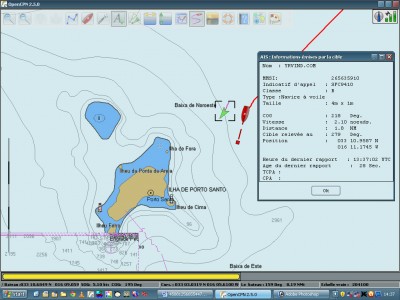To day I have written twenty postcards to freinds. I took a walk to the willage and posted them at the postoffice.
I also bought 3 extra five liter jerrycans with water. I have eight before. Now there is 55 liter water plus some bottles in my boat for the passage more than enough. If all goes well the ferry from Madeira will bring two boxes of grapefruits. The local resturant have promised to keep them in their fridge untill departure. The grapefruit is a gift from the commodore of the Madeira Yachtclub Vasco Bra’s. Manuel Silva and his wife has helped me with all the details here. Everyone here is extremely freindly and helpfull including the authorities.
Nelson The marina manager drove me to the dentist and waited and translated while a touth broken at sea was fixed.
The day before yesterday I dived and scrubbed the hull. I got a bit tired as I did not have any swimming fins on my feet also it was four years since I had been in the water swimming. It was when I sailed to Florida with my 19 year old Captain.
Most things are in place. Only the Garmin map of the West Indies is still somewhere lost in the Madeira post system.
I hope to leave in about a week.
I am longing for the sea. The life for me in port is more boring than the interesting days at sea. I am looking foreward to maybee two peacefull months at sea. Eating my musli and sardines drinking my fill of water, sleeping peacefully through the quite nights. Day after happy day coming, seemingly without end.
I am surprised at all the big boats that turn up here in Porto Santo. By far, I am the smallest. Most of them are longer than 40 feet and I can assure you they cost a fortune, first to buy, then to fit out, then upkeep and running costs. They also have to spend much time here fixing their complex machines and waiting for spare parts and lifting their boats out of the water to fix rudders, propellers and engines.
Often they fly the ARC-flag. ARC is an Atlantic Rally. Between 200 and 300 boats start at the same time from the Canaries in the end of November bound for the Caribian. During the passage they have to daily report their position to the organisers.
ARC is an algoritm or cook book. Its a procedure where you are told how each step are to be taken. You do not have to make your own decision based on your own knowledge. It is like long division or baking a cake. If you do everything exactly according to the book the result will be excelent.
Like cooking and long division you will never know why certain steps are taken. Therefore the the people on the big ARC-boats are surprised and confused to see me in my little boat happily and unafraid sailing the same ocean as they. They foolishly think I do something dangerous. They tell me that the trade wind is not yet established. The do not study pilot and routing charts. Therefore they do not know that the trade wind blows the whole year and that its limets mowes north and south with the sun.
But why should they acquire knowledge. It is very much easier to follow the algoritm or cook book and do what they are told by their experienced leaders, people who know the ocean crossing buissness much better than themself. They listen to the professionals becouse an amateur can never be as good at something as a professional, on the other hand a professional can never enjoy something as much as an amateur. By definition amateur means “lover of”.
What pleasure a person gets from doing what he is told escapes me.
Of course and unfortunatly no one can buy happiness and satisfaction. The big ARC-boats do not experience the same joy as me who has designed, built and sailed my own boat. Therefore I perplex them. I try to explain, but fail. I can not make them understand that I am completly happy in my small boat. On the contrary all their modern conviniences and plenty of space would make my life dull and boring.
Regards Yrvind

